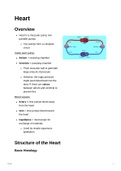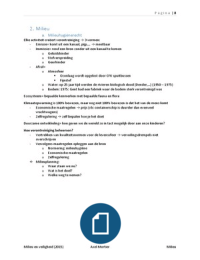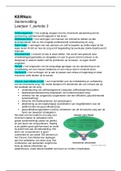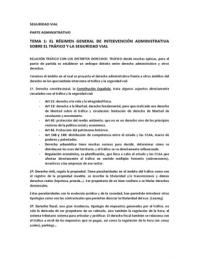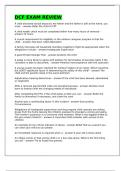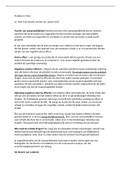Heart
Overview
Heart is a muscular pump, two
parrallel pumps
Two pumps form a complete
circuit
Inside each pump:
Atrium = receiving chamber
Ventricle = pumping chamber
Thick muscular wall to generate
large amount of pressure
However, the huge pressure
might push blood back into the
atria ⇒
there are valves
between atrium and ventricle to
prevent this
Blood vessels:
Artery = One pumps blood away
from the heart
Vein = One pumps blood toward
the heart
Capillaries = microscopic for
exchange of materials
Lined by simple squamous
epithelium
Structure of the Heart
Basic Histology
Heart 1
, Endocardium (simple squamous epithelium) line the heart
Keeps inner surface smooth
Myocardium, aka cardiac muscle line the muscular wall
Epicardium: Serous pericardium + connective tissue
Orientation
Shape of heart = conical
Due to narrow apex
The apex tilts to the left, and rotate
so that the right ventricle faces
anteriorly
Posterior surface = base
Inferior surface = diaphragmatic
surface
Because it rests on the
diaphragm
Anterior View:
Most prominent feature is right
atrium + ventricle
A bit of left ventricle can be
seen
Left atrium is hidden
Atria have auricle (*)
Heart 2
, SVC + IVC is continuous with the
right atrium
Ptrunk is continous with right
ventricle
Aorta arch can be seen
Right pulmonary artery passing
under the aorta arch
2 right pulmonary vein + 2 left
pulmonary vein
Postero-Inferior View:
Base is mostly composed of the left
atrium
Diaphragmatic surface is mostly
composed of the left ventricle + a
bit of right ventricle
Can clearly see pulmonary veins +
arteries + SVC + ICV
Coronary sulcus (groove):
aka Atrioventricular
groove
This is a
boundary
between atria
and ventricles for
Heart 3
Overview
Heart is a muscular pump, two
parrallel pumps
Two pumps form a complete
circuit
Inside each pump:
Atrium = receiving chamber
Ventricle = pumping chamber
Thick muscular wall to generate
large amount of pressure
However, the huge pressure
might push blood back into the
atria ⇒
there are valves
between atrium and ventricle to
prevent this
Blood vessels:
Artery = One pumps blood away
from the heart
Vein = One pumps blood toward
the heart
Capillaries = microscopic for
exchange of materials
Lined by simple squamous
epithelium
Structure of the Heart
Basic Histology
Heart 1
, Endocardium (simple squamous epithelium) line the heart
Keeps inner surface smooth
Myocardium, aka cardiac muscle line the muscular wall
Epicardium: Serous pericardium + connective tissue
Orientation
Shape of heart = conical
Due to narrow apex
The apex tilts to the left, and rotate
so that the right ventricle faces
anteriorly
Posterior surface = base
Inferior surface = diaphragmatic
surface
Because it rests on the
diaphragm
Anterior View:
Most prominent feature is right
atrium + ventricle
A bit of left ventricle can be
seen
Left atrium is hidden
Atria have auricle (*)
Heart 2
, SVC + IVC is continuous with the
right atrium
Ptrunk is continous with right
ventricle
Aorta arch can be seen
Right pulmonary artery passing
under the aorta arch
2 right pulmonary vein + 2 left
pulmonary vein
Postero-Inferior View:
Base is mostly composed of the left
atrium
Diaphragmatic surface is mostly
composed of the left ventricle + a
bit of right ventricle
Can clearly see pulmonary veins +
arteries + SVC + ICV
Coronary sulcus (groove):
aka Atrioventricular
groove
This is a
boundary
between atria
and ventricles for
Heart 3


